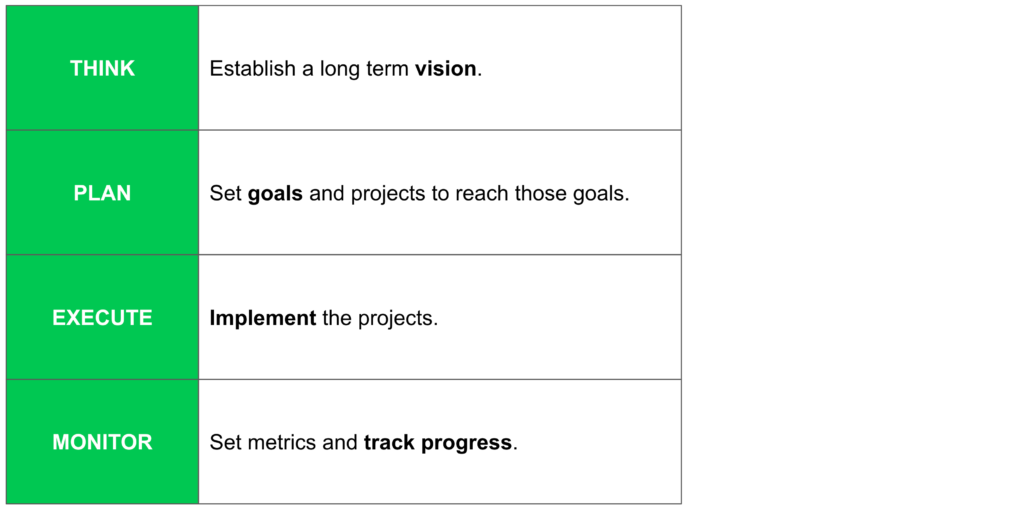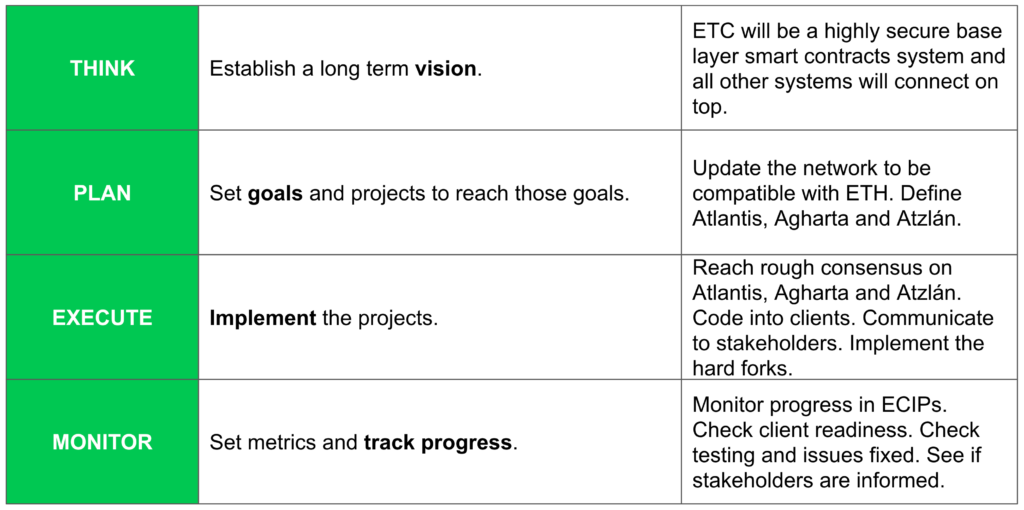You can listen to or watch this article here:
I personally have a tendency, maybe because of my past corporate career, to think about projects and startups from the top down. That is to say, I usually think from a general vision for a project, to goals, to implementation.
The problem is that open source projects, especially blockchains like Ethereum Classic (ETC), have a very decentralized nature, therefore concepts like “vision”, “goals” and “implementation” are things that really materialize as an emerging property from the sum of all the visions, goals and implementations of the different participants and stakeholders of the ecosystem.
However, I think it is natural and effective, at least for coordination purposes, from time to time, for open source ecosystems to gather all that information and align around some general vision, goals and implementations.
Bitcoin as an ecosystem has gone through periods of alignment (pre-2015), misalignment (between 2015 and 2017), and then alignment again today. By “alignment” I don’t mean that everybody thinks exactly the same, but that there is at least a generalized view of the future of the project. For example, there is a current consensus that Bitcoin is a store of value, and that scalability will be achieved primarily through layer 2 solutions and some improvements at the base layer.
As in Bitcoin, I don’t think there is any way that a vision for Ethereum Classic can be, or should be, defined by a centralized entity such as a foundation, as in the case of Ethereum, or a corporation, as in the case of Zcash, EOS, Tezos and others. ETC mostly defines its path through rough consensus (with more emphasis on “rough”!).
So, bearing the above in mind, and in the interest of avoiding governance orgies, but still believing that having a vision, goals and implementation plan to coordinate around is a good idea, I would like to propose a simple framework that could be useful to align the ETC ecosystem…at least from time to time!
A Simple Vision, Goals and Implementation Framework
When a group of people get together to do something there is naturally a process they follow where they think, plan, execute and monitor whatever they are doing.
Putting that together with a simple vision, goals and implementation plan for ETC, I come up with the following framework:

If I add what I personally think is best for ETC, I can use the framework above to come up with a sample plan as follows:

Vision
The vision provides direction, alignment and motivation for participants to focus their efforts. For example, in the sample plan above, the phrase “highly secure base layer” serves as a guidance of what choices, tradeoffs and risks to assume and what technologies to focus on; “smart contracts” determines the specific service ETC will provide; and “all other systems will connect on top” reminds developers and other stakeholders of what technologies and projects not to work on.
Goals
To set goals and specific projects in the planning phase is a way of putting the vision in more concrete terms, with an action plan, and even sometimes defining who will do what activities. For example, “upgrade the network to be compatible with ETH” is an overarching goal that eventually helps achieve the vision of becoming a highly secure base layer with all other systems, which are generally ETH compatible, on top. The Atlantis, Agharta and Atzlán ECIPs are the projects that define the specific components, actions and dates by which the goals will be met and, implicitly, the different client teams (ETC Labs Core, Parity, Multi-Geth and IOHK) who will implement them.
Implementation
The implementation phase is to actually execute the activities defined in the projects to make them a reality. For example, in the case of Atlantis, Agharta and Atzlán, there have to be technical discussions in the forums, and some conference calls between developers and other participants to define the protocol changes. Then, the changes have to be merged into the different clients, and everything needs to be communicated to the rest of stakeholders, so they can deploy the changes. Finally, the hard forks will take place at the predetermined block numbers.
Track progress
To have visibility whether the projects are being effective in meeting the goals and general vision, to track progress in the different activities, and to have the information to stay or correct the course if needed, it is important to set and monitor specific metrics to follow. For example, in the ECIP process it is well defined how the different status terms of the proposals have to advance to be implemented, from Draft to Final. On Github, it is important to monitor whether the software clients are being updated and in which versions. During the testing period, bugs are detected, informed and corrected. And, in the communications efforts, the lists of stakeholder contacts are monitored to see who was contacted, know their feedback and who still needs to be informed.
How Does a Framework Impact the Ethereum Classic Network?
The design choices, network principles and focus of efforts described in the vision, goals and implementation plan define and condition the core protocol design, client development, tool development, L2 systems strategy to follow, and, eventually, the applications independent developers will likely build on top of ETC.
For example, if the vision for Ethereum Classic were “to be highly scalable and fast” perhaps the design choices would have been along the lines of proof of stake and sharding as Ethereum has chosen. If the vision were “store of value” and “privacy” perhaps there would be more emphasis in adopting features similar to Bitcoin, Zcash and Monero.
Another positive impact of having a plan and a coordinated and well communicated vision is that all other stakeholders in the network, such as exchanges, wallets, full nodes, miners, application developers and even other blockchains, can understand and better plan to build and invest on the system.
One example of this is that Vitalik Buterin has recently expressed the option that Ethereum could use Bcash or ETC to secure Ethereum while it migrates to ETH 2.0. In the same manner, counting on a clearly defined vision, all the other stakeholders can plan for and depend on ETC to provide certain features and services when committing time and investment capital developing and adapting their systems to the network.
Communications and Proposed Recurring Activities
One of the most important things to do to enable this kind of emergent planning and coordination, while maintaining a high degree of decentralization and minimizing governance orgy, is to communicate as much as possible. For this, recurring activities, such as the ETC Summit, are extremely important. Also, the forums and community that ETC has built and nurtured in the last three years, such as the Discord chat, the ECIP process and the discussion forums, have been critical to keep the core community together and the rest of the ecosystem and beyond informed.
However, meeting once a year at the ETC Summit, which is a large event, and to be confined the rest of the year to communicate through text and a few live voice chats, still seems limited, especially for debating a more thoughtful long term vision and technical framework for the network and the ecosystem at large.
For the above, in addition to the planning framework described in this article, I recommend the ETC community to establish an intermediate event which focuses on vision and technical projects, definitions and proposals.
Examples, of this kind of meetings in other ecosystems are the Scaling Bitcoin Workshop and the Fellowship of Ethereum Magicians. These kinds of forums are smaller, more intimate, and serve as more tranquil spaces for deeper debates about long term vision and technical discussions. They are also not very costly!
As the general ETC Summit usually occurs in the last quarter of every year, I propose to hold the “ETC Vision and Technical Workshops”, or “ETC Workshops” for short, in the second quarter of every year.
Conclusion
Open source projects, especially in the blockchain space, are very prone to politics and “governance orgies”. However, emergent group planning, while still keeping a high level of decentralization, could still be a good coordinating device to align efforts, energy and capital from the different ecosystem participants and stakeholders to organize around common visions, goals and implementation plans.
In this article I propose a simple vision, goals and implementation framework to follow for the ETC ecosystem. The specific sample plan presented is just my personal vision that I have expressed in many blog posts and on social media. Of course, the potential possibilities and long term paths of ETC can be much more diverse and valuable than just my personal opinions!
Therefore, to promote a more active flow of ideas, I think that to add a recurring forum as the “ETC Workshops” described above, in addition to the ETC Summit, to debate and discuss a more complete vision and technical roadmap for the network, would be very valuable.
Code Is Law